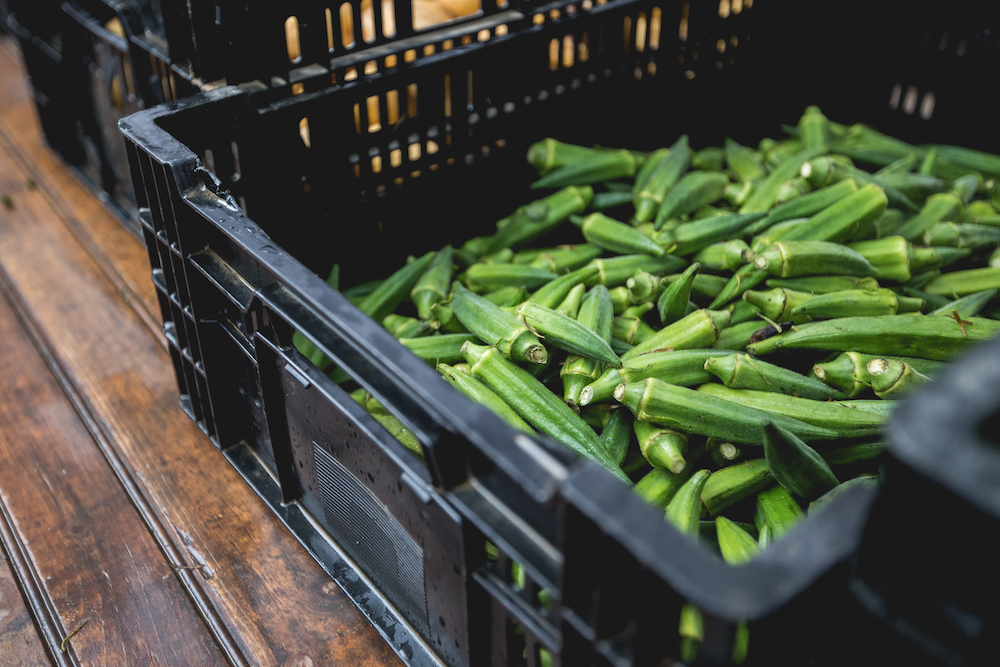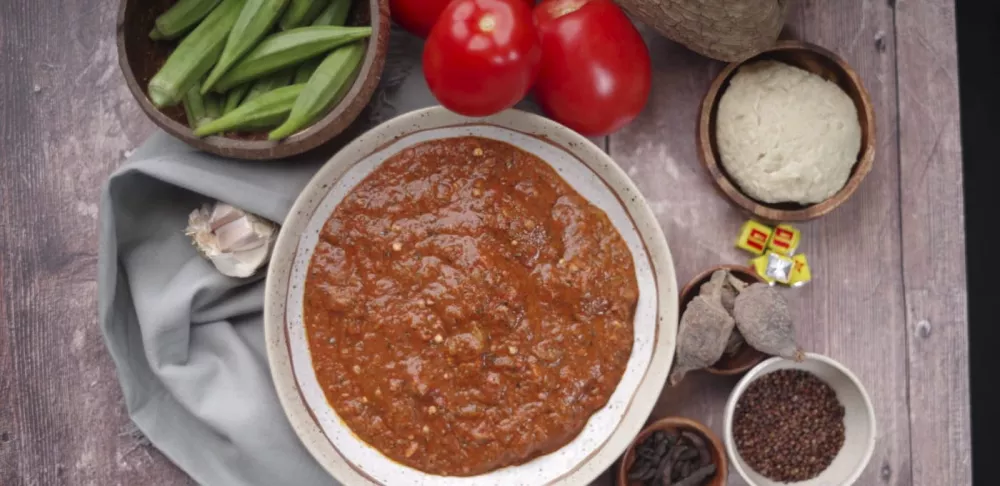Private chef Adjoa Kittoe (Culinary, '21) shares the history and health benefits of okro, the West African word for okra, and the significance of the Ghanian okra stew she grew up with.
Tomato, onion, garlic - the Ghanaian mirepoix is the foundation of most, if not all, Ghanaian soups and stews. Similar to Nigerian okra stew, grains of Selim, cumin and cloves are the aromatics that bring life to our dishes. In this particular dish, nkruma froye (fetridetsi), or okro stew, we see the diasporic connections that refused to die off, regardless of how difficult circumstances were and are today.
Abelmoschus esculentus, okra or okro, as it is called in West African countries, have pods that are as mucilaginous (having a gluey consistency) as their history. From Nigeria to Louisiana, okra is a vegetable that adds texture and depth to a dish. The plant has grown on the African continent since 2,000 B.C. It’s migrated from Africa's Ethiopian borders to the Bantu-Kikongo regions to Kumasi in Ghana and even as far as India and Brazil. In the 21st century, people travel to New Orleans to try the nutty, toasty, intense flavor combinations in a traditional gumbo. The word gumbo even comes from the Kibundu word quingombo. No need for chemicals or additives; okra is a traditional and ancient thickener with nutritional value. In North America, okra is a symbol of resiliency, a reminder of the Maafa or African Holocaust.

Nkruma froye is the traditional name for one of the more famous stews in Ghana. It is created with scotch bonnet pepper, dried crayfish, finely chopped and blended okra, tomatoes, palm oil, and chopped onions and can be mixed with garden eggs (a type of eggplant found in Africa) and spinach. It starts with the Ghanaian mirepoix and then palm oil, ginger and peppers are added. The flavor can be enhanced with chicken bouillon cubes and dried shrimp seasoning. To create a more viscous stew, many aunts and mothers steam the okra with a preferred animal protein.
Similar to gumbo, okra stew can have all types of animal proteins: goat, chicken, fish, shellfish, cow and anything else you can think of. Okra stew can also be enjoyed as a vegetarian dish, without the use of dried shrimp and poultry stock cubes. I preferred to have the dish without meat during my college days when my mother would visit me and drop off a care package.
Among the misconceptions about African food, and African culture in general, are whispers and banter describing eating with your hands as savage behavior that is not proper or civilized — yet the sensory experience of allowing draw soup (Nigerian okra soup) to fall between your fingertips is what adds to the journey of the dish. Our food is an experience and the foundation of many, what some would call, modern dishes today. I see pieces of my favorite childhood dishes in Indian, French and Italian restaurants.
Growing up, I did not eat much Ghanaian food, or so I thought. I craved the American diet of pizza and hamburgers. But living with immigrant parents, as an immigrant myself, we ate what our ancestors ate. Luckily for me, my cuisine was as exciting as a snow day. It brought warmth in cold days and smiles on bitter nights. At times, my mother would ask, “lasagna or okra stew?” I chose okra stew every time. While others complained about its slimy texture, it was a luxury for me. Okra stew was a specialty in my home, and during my visits to Ghana, I had the meal only on Sunday mornings. Although it is a typical dish, it is not something eaten daily, as the side dish, or swallow, is thick enough to put you to sleep.
The stew is generally accompanied by banku, fermented corn cooked and mashed into a consistency of dough. Similar to fufu, banku is a swallow that is used to “pull” the stew, like an edible utensil. The flavor is hard to describe with subtle sour notes. It is firm yet malleable, perfect for grabbing pieces of goat or fish from your soup or stews. The fermentation adds taste and antimicrobial properties. We have intention in our food curation. Okra is rich in vitamin A and C and may lower the risk of heart disease. It’s not common to find someone with heart disease in my native country. Sometimes, when I was feeling ill, I was offered okra stew as a remedy. As it’s 90% water, okra supplied me with the hydration I needed on days when I couldn’t take in much food. In North America, okra stews were eaten with rice, millet, hominy and sometimes corn mush. Similar to the Ghanaian preparation, the okra was boiled with tomatoes and onions and sometimes dark leafy greens.
Okra stew has traveled around the world, making pit stops in India, Brazil, the Caribbean and North America. It has brought richness to the Gulf Coast region and comfort to the West Coast of Africa. Although not eaten with a knife, fork or spoon, the anatomic utensils that we call hands bring intimacy to the meal.
Read more about specialty dish origins, and study global cuisine in Culinary Arts at ICE.




